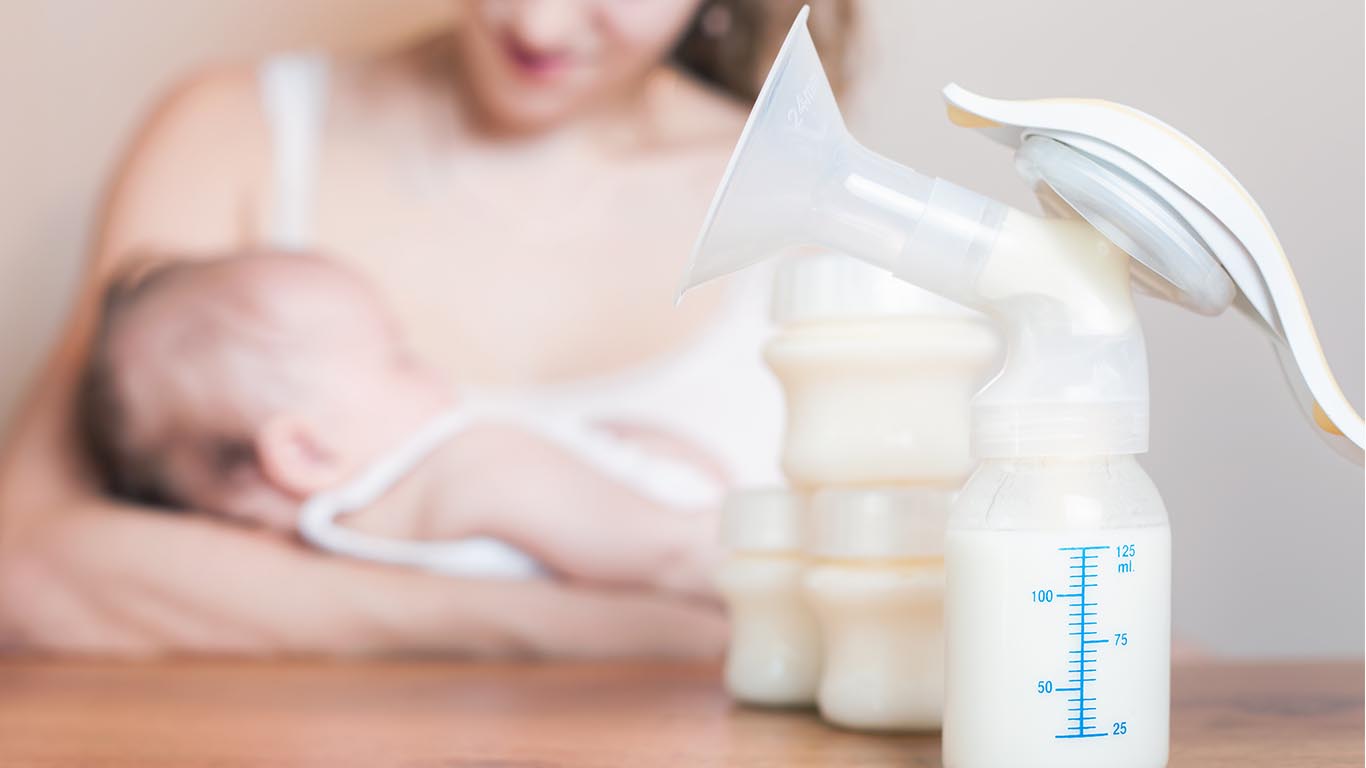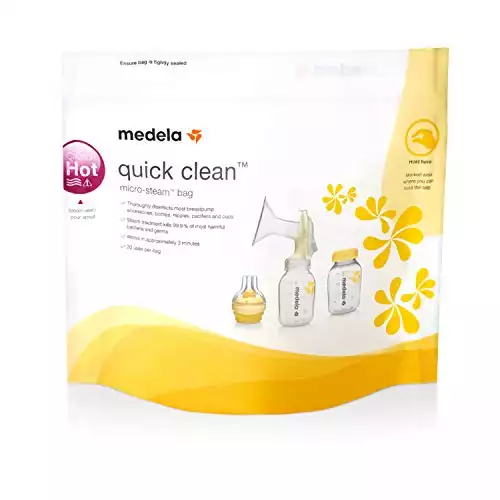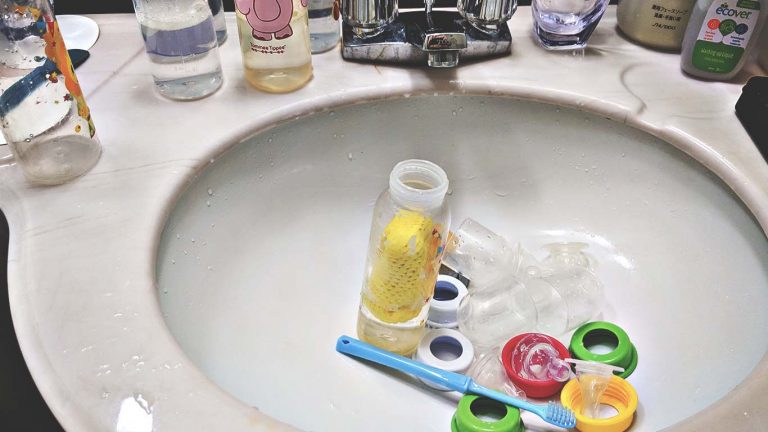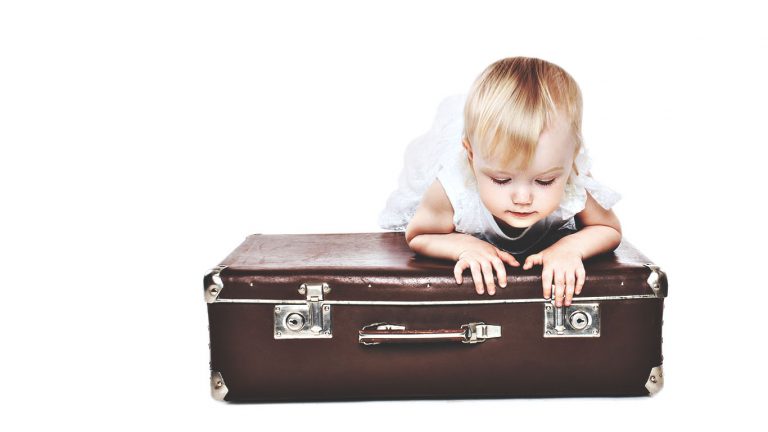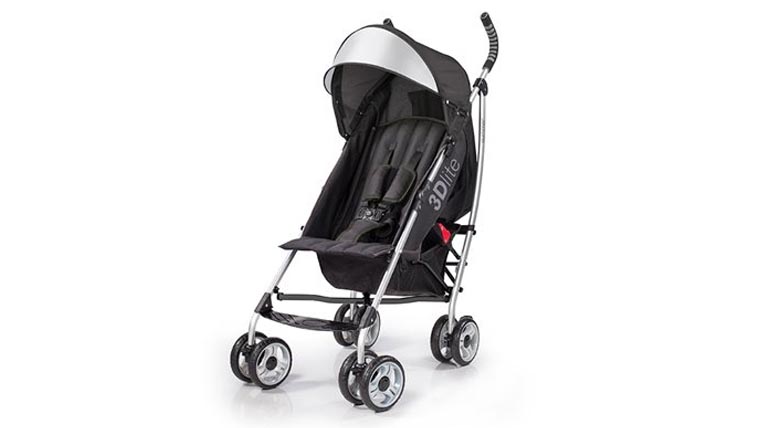Pumping from the comfort of your own home can be a lot of work, but try pumping on the go!
If you’re pumping while you travel, packing the right breast pump is essential.
Find out the best breast pumps for travel to make your life easier.
At a glance: Our top breast pump choices:
- Best hospital grade breast pump for travel – Spectra Baby S1.
- Best premium hospital grade breast pump for travel – Medela Freestyle
- Best manual breast pump for travel – Philips Avent Manual Comfort Breast Pump
The Best Breast Pumps Reviewed
Best hospital grade breast pump for travel – Spectra Baby S1
If you need the power and efficiency of a hospital grade pump, but also want something portable and travel friendly, we recommend the Spectra Baby S1.
This pump is nearly identical to the popular Spectra Baby S2, but comes with a built-in rechargeable battery, making it ideal for pumping on the go.
Many moms have difficulty choosing between the S1 and S2, since both are super efficient and relatively quiet for an electric pump, and both allow you to adjust the settings to fit your preference and optimize milk flow.
The S1 gets the nod from us because it allows you to pump anytime, anywhere, since you don’t have to be near an outlet. The battery power option makes it so you can pump in the car, on a train or plane, or even on a camping trip.
There are a ton of adjustable settings on this pump. You can change the speed and suction power and there’s an optional massage feature, which speeds up the pumping process and makes it more comfortable. The pump also comes with a night light and a timer, which we love.
The S1 can also be used as a single or double pump, allowing you to choose whether you express from one breast at a time or both.
This video shows both the S1 and S2 in action.
One of our favorite things about hospital grade pumps is how hygenic they are.
The S1’s closed system makes it so you don’t have to clean the narrow tubing and prevents bacteria and mold from collecting and finding its way into your baby’s bottle. Let’s be honest, you don’t want to spend any more time cleaning your breast pump than you have to.
Especially while traveling.
What we like:
- The rechargeable battery is an awesome feature, especially for traveling; when fully charged, you can get about 1 hour of use out of it before needing to recharge.
- The S1 is super quiet compared to other hospital grade pumps (great for hotel rooms when your baby or others may be sleeping).
- There is a bundle option which includes a carry tote, which is awesome for traveling!
- It comes with two different size breast flanges (24mm and 28mm).
What we don’t like:
- The bottles that come with the pump are not the highest-quality and have a tendency to tip over. Thankfully, the pump works well with other bottles, including Avent bottles.
- While the S1 is more affordable than a lot of hospital grade pumps, it is still relatively expensive compared to most personal electric and manual pumps.
While no hospital grade pump is going to be as portable, lightweight, and quiet as a manual pump, the S1 is pretty travel friendly at only 3.3 pounds, and makes pumping while your away from home super quick and comfortable. If you know you’ll need to pump frequently on your trip, the S1 a great option.
It’s worth noting that some insurance companies will only cover the Spectra Baby S2 (and not the S1). For some moms (and especially traveling moms), this is a bummer, since the S2 doesn’t come with a rechargeable battery like the S1.
If you need to get the S2 for insurance reasons, but still want to be able to pump on the go, The Pumping Mommy recommends buying a Breastpump Power Bank Kit from Maymom. Note that the power bank cell is sold on its own, so you’ll need to buy the rechargeable batteries separately.
Best premium hospital grade breast pump for travel – Medela Freestyle
You’ll be hard-pressed to find a hospital grade pump that is more portable and efficient than the Medela Freestyle.
Like the S1, the Freestyle comes with a rechargeable battery, which is a great feature if you’re hoping to pump on the plane or during car or train rides. It’s also extremely light and portable, and comes with a cute microfiber carry bag with enough space for all the extra parts and accessories.
There’s even an option to pump hands-free with the Easy Expression bustier, which is sold separately. This makes pumping on the go super easy, and leaves your hands free to pack or unpack your things, get ready for bed, or play with your little one while you express.
The hands-free option also a convenient feature for everyday pumping, allowing you to pump while you do the dishes or clean, make dinner, or while you’re at work.
What we like:
- The rechargeable battery makes pumping on the go much easier, and the battery lasts for about three hours before it needs to be recharged.
- The pump has a digital display with a memory function, backlight (which is great for pumping at night), and a timer. The memory feature allows you to save your favorite pumping pattern, which means you don’t have to reset it each time you pump.
- It comes with two sizes of breast flanges (24mm and 27mm), and you have the option to either single or double pump.
- For an electric pump, the Freestyle is pretty quiet, which is a nice feature for pumping during plane, train, or car rides, or in your hotel room while your baby naps.
What we don’t like:
- While the Freestyle’s digital display is nice, it may take a few goes to figure out. Thankfully, it’s fairly simple once you get the hang of it.
- It’s definitely a little pricier than many of the other electric and hospital grade pumps out there.
Overall, the Medela Freestyle is a great pump for traveling, particularly with the hands-free Easy Expression bustier.
If you’ve decided to go the hospital grade route, and you don’t mind spending a little extra to get something portable and quiet, this is definitely our top pick.
Best manual breast pump for travel – Philips Avent Manual Comfort Breast Pump
If you’re looking to travel as light as possible, but still want a great pump that is comfortable, easy to use, and gets the job done, the Philips Avent Manual Comfort Breast Pump is a great option.
It’s compact, lightweight, and about as portable as you can get since it doesn’t require a power source. It also comes with a travel cover, which helps keep it clean when it’s in your diaper bag, purse, or luggage.
While it’s difficult for manual pumps to compete with electric ones when it comes to efficiency, the Avent Comfort does a good job at producing a decent amount of milk in a relatively short period of time, and you can use it anywhere!
The pump is designed so you can sit normally (instead of having to lean forward like you do with some manual pumps) and it has a gentle, textured massage cushion/flange that makes expressing more comfortable and helps stimulate milk flow.
You get one 4-ounce Avent Natural bottle and a sealing disc with your purchase. The pump is also compatible with other Avent products, like the Classic bottles and milk storage containers.
One of the best hings about this pump is how ergonomic the handle is and how easy the pumping process is on your hand. Some manual breast pumps make your hand hurt or cramp up, but the pump on the Avent Comfort is comfortable and easy to use.
What we like:
- The Avent Comfort is super quick and easy to clean. There’s no tubing and all the pieces are dishwasher safe.
- It’s extremely compact, portable, and lightweight; super convenient for traveling!
- It has awesome suction for a manual pump, and the ergonomic handle and massage cushion make it comfortable and easy to use.
- There are a variety of add-ons and accessories you can buy (including different size breast flanges/comfort pads) and the pump is compatible with other Avent products.
What we don’t like:
- The pump has a tendency to make a squeaking noise, which can be pretty annoying if your baby is sleeping or if you are trying to be discreet. However, if you disassemble the entire pump (including the handle and diaphragm) when you wash it, it stays quiet.
- It definitely takes longer than an electric pump and doesn’t allow for double pumping. Although, this is true for just about any manual pump, and many moms find that the portability factor makes it totally worth it.
Overall, the Avent Comfort is a great manual breast pump for traveling and on-the-go use.
It’s comfortable and convenient, and allows you to express anytime, anywhere (even when you don’t have access to a power source).
We highly recommend it if you’re looking for a super compact, lightweight manual pump to take with you on your adventures.
Cheaper alternative manual breast pump – Medela Harmony Manual Breast Pump
If you’re traveling and pumping on a budget, or if you don’t travel often and don’t want to spend a ton of money on a pump you might not use all that often, we recommend the Medela Harmony Manual Breast Pump.
The Medela Harmony has a lot in common with the Avent Comfort. Both are super small and lightweight, designed for single pumping, and require you to pump manually.
The fact that the Harmony doesn’t come with a power source, extra tubing, or lots of extra parts makes fitting it into your suitcase or carry on much easier than an electric or hospital grade pump. This also makes it quick and easy to clean.
This pump is great for pumping discreetly while flying or on a train or bus, since it’s super quiet and you don’t have to worry about the battery running out and needing to be recharged.
Although not as efficient or convenient as electric pumps, the Harmony gets the job done relatively quickly, and comes with a soft-touch swivel handle, which makes your hand less likely to cramp up.
What we like:
- This pump couldn’t be quieter. This is great for pumping at night, while your little one naps, or on a plane.
- The Harmony works with the same bottles as Medela’s electric pumps, including the Freestyle, so if you have an electric Medela pump at home, you can use the same bottles interchangeably.
- The fact that it’s so small and portable and doesn’t come with a ton of extra parts to worry about makes tossing the pump in your diaper bag, carry on, or purse really easy. Being able to carry it with you wherever you go also means that if you get stuck in traffic or have to wait at the airport or train station for a few hours, you can pump while you wait.
What we don’t like:
- The small o-ring on the pump’s handle has a tendency to move around a bit, so you may have to check it a couple times during pumping sessions to make sure it’s still in place.
- Unlike the Avent Comfort, the Harmony is not dishwasher safe, so it takes a little extra effort to clean.
If you’re looking for an affordable, simple-to-use, and super quiet manual pump to take with you while traveling, the Harmony is definitely worth considering.
It doesn’t come with all the bells and whistles you’ll find with some electric pumps,
You also don’t have the option of double pumping, but if your top priority is finding something quiet and convenient that you can easily throw in your carry on, and you don’t want to break the bank, this is a good option.
Types of breast pumps explained
There are 4 general types of breast pumps: hospital grade, electric, battery operated, and manual.
It’s worth noting that the first three types are not mutually-exclusive; most hospital grade pumps are electric, and many electric pumps come with a battery power option for when you don’t have an outlet handy.
Each type of pump has its advantages and disadvantages, and which one is right for you will depend on your unique circumstances as well as your specific travel plans.
Hospital grade
Hospital grade breast pumps (like the Spectra Baby S1 and the Medela Freestyle) are the strongest and most efficient type of pump you can get. Because of their powerful motors and suction strength, they are often recommended to mothers of twins or preemies and to moms who have problems breastfeeding or producing enough milk.
Unlike other types of breast pumps, hospital grade pumps can be used by multiple people (so long as each user has their own collection kit). This makes renting or borrowing a hospital grade pump an option for moms who only need to use one for a short amount of time.
Hospital grade pumps are almost always designed for double pumping (meaning you can express milk from both breasts at once). Not only does this save time, it also results in increased milk production. However, some hospital grade pumps are double/single, meaning you can choose if you want to express from one breast or both breasts at once.
The downside of hospital grade pumps–especially for traveling–is that they are bigger and bulkier than personal electric pumps and manual pumps. They also tend to be louder and less discreet than manual pumps.
While they are more difficult to pack and transport—and are more restrictive, since you either need an outlet or a charged battery—you can’t beat the efficiency and power of a hospital grade pump, and if you struggle with milk flow, this is likely your best option.
Electric
If you don’t need the added speed and power of a hospital grade pump, or if you’re looking for something a little more portable and/or affordable, a personal electric pump is your second most powerful option.
Electric pumps are popular among moms who are going back to work because they are quick and effective. Most personal electric pumps are designed for double pumping, but you can also get single electric pumps if you want something more compact and lightweight.
Electric pumps tend to be louder than their manual counterparts, and they require you to be stationary while you’re using them, since they need to be plugged in. However, some electric pumps (like the Spectra S1 and the Medela Freestyle) come with a battery power option, which provides a bit more flexibility.
Battery operated
Battery operated pumps are generally cheaper, smaller, and more lightweight than electric pumps. They’re great for when you need to express on the go, as they don’t require an electrical outlet.
However, the pumping process takes a bit longer with battery operated pumps compared to electric, since they are less powerful and typically only allow you to express one breast at a time.
This is true for hospital grade and personal electric pumps with battery power options as well. When your pump is is not plugged in and is running on battery power, it takes longer to produce the same amount of milk.
That being said, battery operated pumps are still generally faster and more powerful than manual pumps, and they can be a good option if you’re looking for something more portable.
Manual
Manual breast pumps are the cheapest, quietest, and most portable type of pump you can get.
While they take more time and effort to use (since you are using your hand to express the milk instead of a motor), many moms find that they are ideal for traveling because they’re so compact, lightweight, and quiet.
If you’re looking for something that you can easily throw in your carry on, diaper bag, or even your purse, a manual pump is probably your best bet.
One disadvantage of manual pumps is that they typically require you to use both hands—one to express, and one to hold the bottle—although there are some manual pumps on the market, like the Avent Comfort, that can be used with only one hand.
Because they are smaller and typically have fewer parts, manual pumps are generally pretty quick and easy to clean, which is definitely a bonus when you’re traveling.
Do you need a breast pump while traveling?
Not everyone wants or needs to bring a breast pump when they’re away from home.
Every additional item in your luggage takes up space, and even a small manual pump is not worth bringing if you’re not going to use it.
However, depending on your travel plans, being able to express while your baby is sleeping or when they’re not with you, and being able to bottle feed them while you’re out and about and unable to breastfeed, can make feeding your little one while you’re away from home much easier.
Also, if you’re traveling without your baby, or if you plan to be away from them for several hours at a time, having a breast pump handy to relieve engorged breasts can be a lifesaver.
Even if you don’t usually use a breast pump or you have a particular type of pump that you like to use at home, it’s worth considering whether or not one would be useful to you while you’re on your trip and, if so, what type would be most convenient for travel.
Flying with your breast pump
Flying with a breast pump (and pumping on a plane) can be a bit stressful, especially if you’ve never done it before and aren’t familiar with air travel restrictions and regulations.
The International Lactation Consultant Association recommends against checking your breast pump in your suitcase or as a standalone item.
It’s not an item you want to be without if your luggage gets lost or damaged. Also, depending on the length of your flight and the type of pump you’re using, you may also want to express while you’re in the air, so it’s generally better to pack your pump as a carry on item.
Thankfully, most airlines will count your pump as a “medical device,” meaning it won’t count toward your carry on limit; however, coolers and milk storage containers/bags may. It’s important to check with your specific airline(s) to make sure you understand their policies and restrictions before you arrive at the airport.
Expressed milk is also considered a “medicine” for security purposes and is therefore not subject to the usual carry on liquid restrictions. That being said, it is still subject to screening and the rules are known to change, so always double check.
It’s a good idea to tell airport security that you are traveling with a breast pump and/or breast milk to limit confusion and make the security/screening process faster.
Breast pumps and expressed milk can both go through the x-ray machine without adverse effects, but if you prefer that your milk doesn’t, you can request an alternate screening method.
When it comes to pumping while you’re on the plane, you have two options: the
- Use the plane restroom
- Pump in your seat.
Both options are perfectly acceptable (lots of moms pump and breastfeed on planes) and it really comes down to personal preference.
Here is a list of items you may want to bring with you when traveling with a breast pump:
- Breast pump (obviously)
- Power convertor/adapter (if you’re traveling internationally)
- Batteries and extra batteries
- All relevant accessories (power cord, tubing, flanges, membranes, bottles, etc.)
- Nursing cover
- Milk storage bags and freezer packs (if you plan to bring milk home with you)
- Cleaning supplies
- Hand sanitizer and/or sanitizing wipes
Driving with your breast pump
If you’re taking a road trip or renting a car when you get to your destination, you might want to consider pumping while you’re in the car.
Pumping while you drive (or as a passenger) can help you maximize your time and relieve engorged breasts on long car rides. This is especially helpful if your baby is able to nap in the car and you don’t want to wake them up to breastfeed.
Of course, it’s important to consider whether or not you can pump safely and legally while you drive. If you find the process distracting, or if it limits your range of motion, it’s better to wait for another time. If you’re someone who can simply turn on the pump while you’re wearing a hands-free bra or bustier and focus on driving, then it can be a really efficient and easy option.
It’s important to make sure you set the pump up properly before you start driving, and are able to completely ignore it while you’re on the road.
You’ll want to be sure to adjust any settings and make sure you’re comfortable before you start driving, and resist the urge to check the bottles or re-adjust your hands-free bra while on the road. Safety first!
If you feel comfortable pumping while you drive, it’s still important to make sure you check the local laws and statutes before you decide to pump on the road. If your trip involves driving through multiple countries, provinces, states, or districts, you’ll want to be sure to check the laws in each place you plan to drive through.
Although some electric pumps come with a rechargeable battery (like the Spectra S1 and the Medela Freestyle), if yours doesn’t have one, or if you plan to be on the road for several hours and need to pump more than once, you may need to buy a car adapter to make sure you have access to power while you pump and drive.
Keeping your breast pump clean
Cleaning your breast pump can be a hassle, especially when you’re away from home.
Depending on the pump, you may be able to wash some or all of the parts in the dishwasher.
Other pumps need to be cleaned in the sink using soap and water.
These cleaning methods work great if you have access to a kitchen, but many hotel rooms don’t have a sink, let alone a dishwasher.
An awesome solution is to use microwave disinfecting bags to clean your breast pump while traveling (or any time, for that matter). With these bags, all you need is access to a microwave, which many hotel rooms provide.
Check out this guide for more advice on surviving hotel rooms with a baby.
All you have to do is toss any used parts from your pump into one of these bags and pop them into the microwave for a few minutes. The process couldn’t be quicker and easier, and everything will be sterile and ready to go the next time you need to pump.
During the day, if you want to quickly clean your pump after using it, you can also use sanitizing wipes or spray to remove most of the bacteria and germs from your pump parts.
Just make sure you also give the pump a good, thorough cleaning in the dishwasher, sink, or microwave every once in a while!
The bottom line
Whether you decide to take a hospital grade, double electric pump like the Spectra Baby S1, or stick with a simple and quiet manual pump like the Avent Comfort, we hope you found our product recommendations and tips and tricks for pumping while you travel helpful.
Pumping while traveling takes a little bit of planning ahead, and its important to make sure you have the right pump (and all the other supplies you need) to meet your individual preferences and your travel plans.
With the right gear, pumping while traveling doesn’t have to too much of a hassle.
